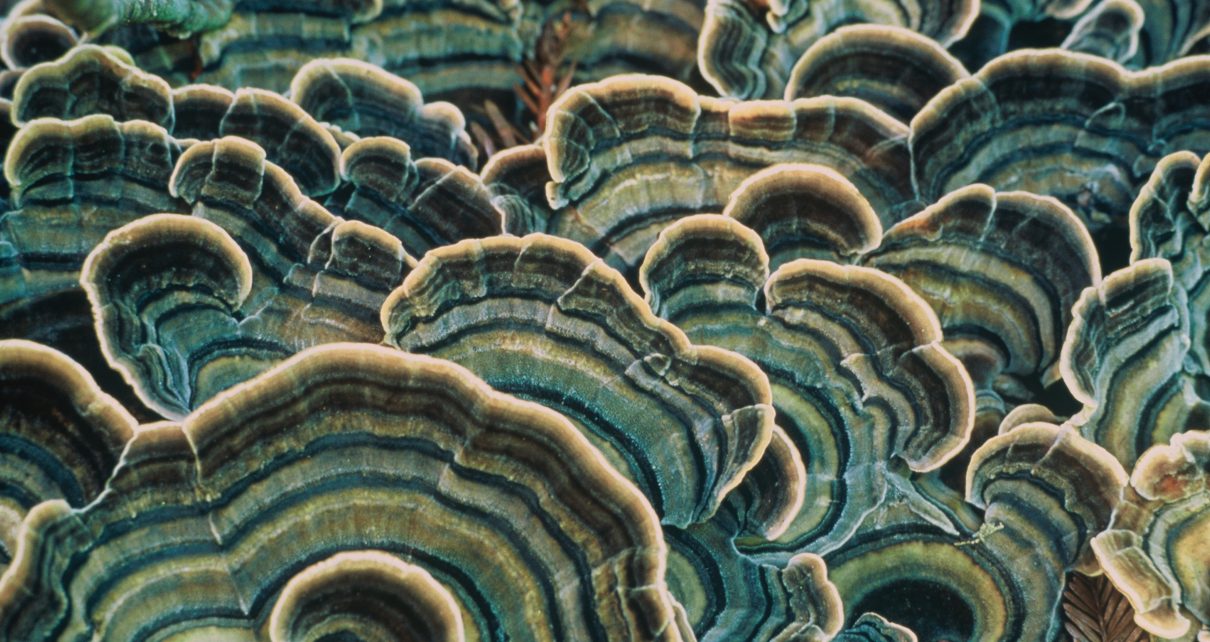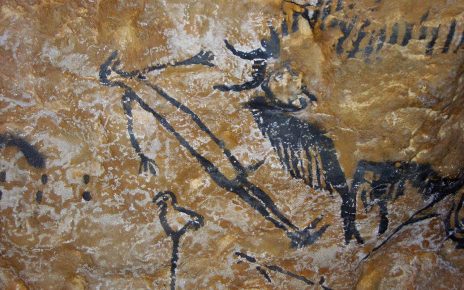In his book Entangled Life, scientist Merlin Sheldrake introduces us to vastly underappreciated players in the story of our planet. Fungal species count in the millions—the true number is unknown. And they serve as a platform for, and partner in, almost every aspect of life. No fungi, no us. Sheldrake’s book is a poetic letter to the associates we never knew we had. He recently answered questions about the nature of intelligence, psychedelic drugs, and creative home brews from Mind Matters editor Gareth Cook.
[An edited transcript of the interview follows.]
Why have you been drawn to study fungi?
I’ve always been fascinated by the way things transform. A solid log becomes soil, sugar becomes alcohol, a lump of dough rises into bread. But how? My questioning often led me back to fungi—metabolic wizards with a breathtaking capacity to arrange and rearrange the world. Fungi can digest many things, from wood to rock to kerosene. And without their powers of decomposition, our lives would be inconceivable. If nothing decomposed, the earth would pile up kilometers-deep with the bodies of animals and plants. I remember trying to wrap my head around this idea as a child and feeling dizzy: Our lives take place in the space that decomposition leaves behind. Composers make; decomposers unmake. And unless decomposers unmake, there isn’t anything that the composers can make with. It was a thought that changed the way I understood the world—and one that continues to fuel my curiosity about these organisms, which are responsible for so much yet live largely out of sight.
As my biological studies progressed, I became increasingly interested in symbiosis, the close relationships formed between unrelated organisms. Life is a story of intimate collaboration. And fungi are major players in some of the most blockbuster symbioses in the history of the planet. For example, plants only made it out of the water around 500 million years ago because of their relationships with fungi, which served as their root systems until plants’ ancestors were able to evolve their own. Today almost all plants depend on these fungi (known as mycorrhizal fungi, from the Greek for fungus, mykes, and root, rhiza), which form intricate networks that lace through the soil and scavenge for nutrients that they trade with their plant partners.
Learning about these relationships made the world look different. At high school, I had been taught to think of plants as autonomous individuals. But they turned out to be the product of a complex tangle of relationships: mycorrhizal fungi are a more ancient part of plant-hood than wood, leaves, flowers or even roots. What we call plants are really algae that have evolved to farm fungi and fungi that have evolved to farm algae. And their ancient relationship lies at the base of the food chains that sustain nearly all life on land. This was—and remains—a huge thought for me. I found myself full of questions and decided to study this world-making association and its subterranean networks of influence. I’m yet to emerge from this tangled enquiry and don’t imagine that I will any time soon. Fungi have received a tiny fraction of the attention given to animals or plants and we’re only just beginning to understand this mind-bending kingdom of life. There are wide-open questions whichever way one looks.
You write about how fungi challenge the ways that we might think about intelligence. Can you explain this idea?
Classical scientific definitions of intelligence use humans as a yardstick by which all other species are measured. From this perspective, intelligence requires at least a brain and, more usually, a mind. Because fungi, like plants, don’t look or behave like us—or have brains—they have long fallen well short of these anthropocentric requirements. Thankfully, over the last few decades, the concept of intelligence has deepened and expanded. Brains didn’t evolve their tricks from scratch: many of their characteristics reflect more ancient processes that existed long before recognizable brains arose. Today many argue that it is less helpful to think about whether organisms are intelligent or not—and more productive to ask to what degree an organism (or, indeed, a computer) might display intelligent behaviors. There are a variety of definitions in circulation. Most refer to the ability of an organism to receive and process information from their environment, solve problems, adapt to new situations, and make choices between alternative courses of action.
Within this more inclusive picture, there are a number of ways that fungi press hard on questions of intelligence. Mushrooms are only the fruiting bodies of fungi: for the most part fungi live their lives as branching, fusing networks of tubular cells known as mycelium. These networks can sprawl over tens or even hundreds of meters and are subject to an unceasing flood of sensory information. And somehow, without a brain, fungi are able to integrate these many data streams, make decisions, and determine suitable courses of action. Fungi can find the shortest path between two points in a labyrinth (rather like slime molds, or Physarum, which have become poster organisms for brainless problem-solving). They can hijack insect bodies and control their behavior with an astonishing degree of precision. They can negotiate intricate trading relationships with plants. They maintain countless channels of communication with other organisms and with distant parts of themselves. The mycelium of some fungal species is electrically excitable and conducts spikes of electrical activity (analogous to the electrical impulses in animal nerve cells), and researchers are working on ways to use fungal networks as living circuit boards, or “biocomputers,” – that can solve routing problems or serve as environmental sensors.
Why do some fungi produce mind-altering drugs such as psilocybin?
The metabolic ingenuity of fungi impacts human lives in a number of ways: bread, alcohol, cheese, soy sauce, penicillin, anticancer drugs, immunosuppressant drugs that enable organ transplants—it’s a long list. But the ability of some fungi to make mind-altering chemicals, such as psilocybin, that slip into the workings of our brain is particularly intriguing and has long been a source of puzzlement and speculation. Both fungi and plants produce a wide range of substances that have a mind-altering effect on animals. Sometimes these compounds act as deterrents: nicotine, for example, is produced by some plants and paralyses insects, whereas caffeine suppresses their appetite. Mushrooms such as the death cap defend themselves with deadly poisons. Hallucinogens contained in other plants and fungi may serve to baffle herbivores and take their minds off their next meal. Ergot fungi, from which the psychedelic drug LSD was originally derived, induce a grisly portfolio of symptoms —from convulsions to a sensation of unbearable burning—which suggest that these chemicals may have evolved to discourage animal pests. (I should add that LSD itself shares none of these qualities.)
The case of psilocybin is less clear-cut. The current best estimate puts the origin of the first “magic” mushroom around 75 million years ago, among wood-rotting and dung-loving fungi—tens of millions of years before our genus Homo evolved. These habitats are also home to insects that eat or compete with fungi, leading some researchers suggest that psilocybin, with its potent neurological activity, may have evolved to defend mushrooms from hungry animals by causing confusion or suppressing their appetite. The problem is that if psilocybin has evolved to be a deterrent, it’s not very effective. There are species of gnat and fly that routinely make their homes within magic mushrooms. Snails and slugs devour them without apparent ill effect. And leaf-cutter ants have been observed actively to forage for a certain type of psilocybin mushroom and carry them back to their nest in one piece. These observations have led some to propose that psilocybin instead acts as a lure, somehow changing animal behavior in a way that benefits the fungus—although how, exactly, isn’t clear. The answer probably falls somewhere in between. Psilocybin mushrooms that are toxic to some animals could still make a good meal for those able to develop resistance. Some species of fly are resistant to the poisons produced by death cap mushrooms, for instance, and have near-exclusive access as a result.
Interestingly, today many psilocybin-producing fungi find themselves in a very different predicament. Whatever benefit psilocybin originally provided, its interaction with human minds has transformed the evolutionary fortunes of those fungi that can make it. Psilocybin certainly doesn’t act as a human repellent—to stand a chance of overdosing, a human would have to eat around 1,000 times more mushrooms than required for an average trip. Quite the opposite, in fact. Humans seek out psilocybin-producing fungi, transport them around the world and have worked hard to develop new methods to cultivate them. (Humans don’t seem to be the only creatures to take an interest: Michael Beug, one of the mycologists in charge of the poisoning reports filed by the North American Mycological Association, told me that there are a number of cases of dogs eating psychoactive mushrooms with effects that appear familiar to human observers. Only once has he dealt with reports of a cat which ate mushrooms repeatedly and seemed to become quite “bemushroomed.”) A new story of domestication is in full swing. In cupboards, bedrooms and warehouses, a handful of tropical fungal species are making new lives in otherwise inhospitable temperate climates. In colliding with a new type of animal, a chemical that might once have served to fuddle the wits of pests has been transformed into a glittering lure.
Speaking of domestication, I understand that you are fond of fermentation projects. What do you make at home? And if you were offering a taste of something to a guest, what would you choose?
Yes, I’m very fond of fermentation. Besides the fine flavors and health benefits, there’s the satisfying confusion of who —microbe or person—is domesticating who, a perspective shift that I find to be good medicine for my human-centeredness. My brother Cosmo and I have a fermentation shed where we make all sorts of things. Pickles, kimchis, and sauerkrauts are staples, as are fermented hot sauces—our chipotle hot sauce is a perennial favorite. There’s also a drink called beetroot kvass, which tastes deep and life-giving and quite unlike anything else: rich and earthy, with a twang. It’s wonderful drunk on its own but can also be mixed into any number of cocktails. If a guest showed up unannounced, I’d definitely reach for the kvass.
And then there are the alcoholic drinks, which range from dry meads to nettle beers. I made a cider with apples harvested from Isaac Newton’s apple tree—called Gravity. (Three of these trees grow in Cambridge, England—planted from cuttings taken from an old tree at Newton’s family home.) And there was a delicious cider that Cosmo and I made with apples collected from the orchard at Charles Darwin’s house, which we called Evolution. I particularly enjoy brewing from recipes documented in historical texts. Old brewing recipes are records of how yeasts have etched themselves into human lives and minds over the last few hundred years. Yeasts were only discovered to be microscopic organisms in the 19th century, which means that in many of these texts, yeasts are a silent companion—an invisible participant in human culture. Indeed, the transformational power of yeast has long been personified as a divine energy, spirit, or god. Ultimately, brewing recipes are stories that make sense of how substances decompose and are a good reminder that it matters what stories we tell. The story you hear about grain determines whether you end up with bread or beer. The story you hear about milk determines whether you end up with yogurt or cheese. The story you hear about apples determines whether you end up with sauce or cider.




